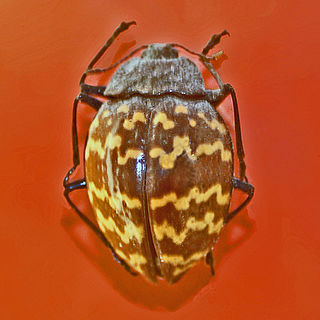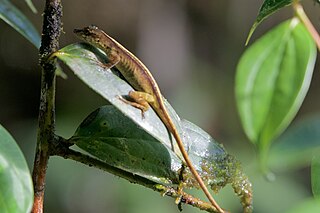
The spined soldier bug is a species of stink bug common in North America. They are predators of gypsy moth caterpillars and the larvae of beetles such as the Colorado potato beetle and the Mexican bean beetle. Since the Mexican bean beetle is widely regarded as a notorious agricultural pest in North America, soldier bugs are generally considered to be beneficial garden insects.

Physalaemus maculiventris is a species of frog in the family Leptodactylidae. It is endemic to Southeast and South Brazil and is known primarily from the Serra do Mar in Espírito Santo, Rio de Janeiro, São Paulo state, Paraná, and Santa Catarina states. Common name Mantagnes dwarf frog has been proposed for it.

Pyrrhalta viburni is a species of leaf beetle native to Europe and Asia, commonly known as the viburnum leaf beetle. It was first detected in North America in 1947 in Ontario, Canada. However, specimens had been collected in Annapolis Royal, Nova Scotia in 1924. In 1996 it was discovered in a park in New York, where native plantings of arrowwood were found to be heavily damaged by larval feeding. The UK-based Royal Horticultural Society stated that its members reported Pyrrhalta viburni as the "number one pest species" in 2010.
Synanthedon maculiventris is a moth of the family Sesiidae. It is known from Cameroon.
Oricopis insulana is a species of beetle in the family Cerambycidae. It was described by Arthur Sidney Olliff in 1890.
Oricopis is a genus of longhorn beetles of the subfamily Lamiinae.

Erotylus is a genus of beetles in the family Erotylidae.
Oricopis mediofasciatus is a species of beetle in the family Cerambycidae. It was described by Stephan von Breuning in 1959.
Oricopis intercoxalis is a species of beetle in the family Cerambycidae. It was described by Lea in 1917. It is known from Australia.
Oricopis setipennis is a species of beetle in the family Cerambycidae. It was described by Lea in 1917. It is known from Australia.
Oricopis flavolineatus is a species of beetle in the family Cerambycidae. It was described by Stephan von Breuning in 1939. It is known from Australia.
Oricopis guttatus is a species of beetle in the family Cerambycidae. It was described by Blackburn in 1894. It is known from Australia.
Oricopis umbrosus is a species of beetle in the family Cerambycidae. It was described by Francis Polkinghorne Pascoe in 1863. It is known from Australia.
Eunidia maculiventris is a species of beetle in the family Cerambycidae. It was described by Thomson in 1868.

Megacerus is a genus of large-horned bruchines in the family Chrysomelidae. There are about 9 described species in Megacerus in North America.
Gyrinus maculiventris is a species of whirligig beetle in the family Gyrinidae. It is found in North America.
Megacerus maculiventris is a species of leaf beetle in the family Chrysomelidae. It is found in Central America, North America, and South America.
Oricopis rufescens is a species of beetle in the family Cerambycidae. It was described by Stephan von Breuning in 1969.

Anolis maculiventris, the blotchbelly anole, is a species of lizard in the family Dactyloidae. The species is found in Ecuador and Colombia.





